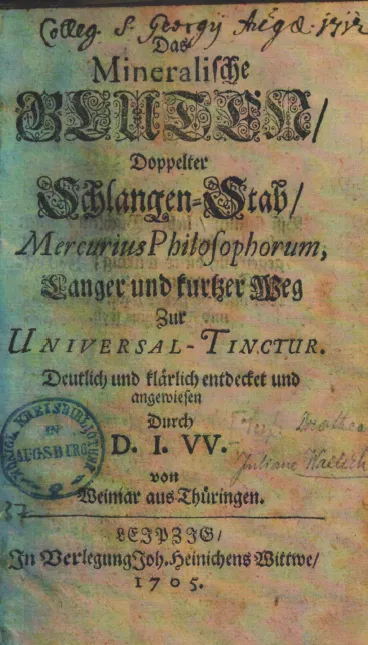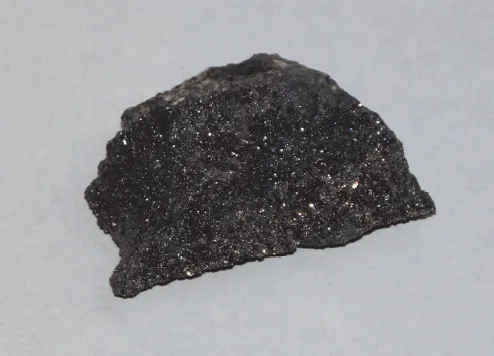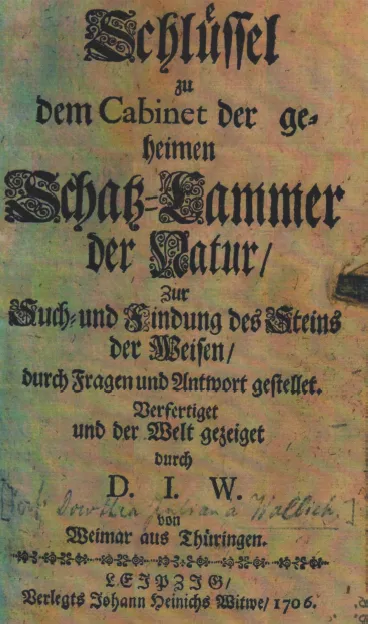![]()
Part 1
Old and New Understandings of the Elements
![]()
Dorothea Juliana Wallich (1657–1725) and Her Contributions to the Chymical Knowledge about the Element Cobalt
Alexander Kraft
Network Alchemy at the Gotha Research Centre of the University of Erfurt, 99867 Gotha, Germany
Although cobalt compounds had already been in use for colouring glass and ceramics for centuries, the Swedish chemist Georg Brandt (1694–1768) is usually credited with discovering the element in 1735 [Weeks, 1960]. In the Acta literaria et scientiarum Sveciae of that year, Brandt published a detailed account in which he showed that cobalt was clearly distinct from bismuth after he had produced both metals from the same ore [Brandt, 1735]. But cobalt compounds were commercial products and objects of research long before Brandt’s important publication. In 1705 and 1706 Dorothea Juliana Wallich published three chymical books under the pseudonym D.I.W. [Wallich, 1705a, 1705b, 1706]. These books were the result of her work with a cobalt-containing ore, and focussed on producing the philosophers’ stone which was supposed to transmute metals such as lead and tin into silver and gold. Wallich also recorded some chymical experiments with cobalt compounds. By discovering the thermochromic reactions of certain cobalt compounds she contributed to the early understanding of the properties and behaviour of the element cobalt.
Dorothea Juliana Wallich and her Chymical Work
Dorothea Juliana was born in 1657 in the central German town of Weimar as Dorothea Juliana Fischer. Her father was Heinrich Fischer (1611–1665), the First Tax Collector for the Duke of Saxe-Weimar; her mother, Anna-Catharina Lippach, was the daughter of the well-known Protestant theologian David Lippach (1580–1653). On 1 March 1674, at the age of 16 years and seven months, Dorothea Juliana Fischer married the 34-year-old Johann Wallich, the Court Secretary of the Duke of Saxe-Weimar. The couple was wealthy, lived in Weimar and did not have any children [Kraft, 2017].
Around 1685, when Wallich was in her late twenties, she became interested in chymistry (the chemical practices of the time) including practical laboratory experiments.1 Wallich engaged intensely with chymistry for the following 20 years and became a renowned expert in the area of Thuringia and Saxony.
Unfortunately, not much is known about her life prior to the publication of her three books in 1705/6. From this twenty-year period only small pieces of information survive, which Georg Ernst Stahl (1659–1734) published in a book [Stahl, 1718, pp. 249, 252–253] and put down in 1728 in a letter to the physician, chemist and mineralogist Johann Friedrich Henckel (1678–1744) in Freiberg in Saxony [Stahl, 1795, pp. 99–100]. Stahl was a prominent physician and chymist himself, a professor of medicine at the university of Halle between 1694 and 1715, and the First Court Physician to the king in Prussia in Berlin from 1715 until 1734. His development of the phlogiston theory2 helped to pave the way from chymistry to modern chemistry [Beck, 1960].
Stahl lived in Weimar with his family between early 1687 and 1694. At the time he was the personal physician of the duke Johann Ernst III of Saxe-Weimar (1664–1707, duke from 1683). Stahl knew Wallich very well: she was godmother to one of his daughters from 1690 onwards [Kraft, 2018]. According to Stahl, Wallich “had certainly more experience in chymical things ... than a large number of very scholarly and intellectual men” [Stahl, 1718, p. 249]. Stahl further reported that Wallich had been active for a while in the Saxon mining town of Schneeberg, successfully extracting more silver from cobalt ores than other chymists were able to do. Her three books were written in German and published in 1705 and 1706. They were the result of her chymical work, both in the laboratory and from studying the chymical literature of the time. Figure 1 shows the title page of Wallich’s first book. Wallich wrote these books because she thought that she had found the secret “minera” that was considered necessary for producing the philosophers’ stone.
Wallich called this “minera” or ore “Electrum minerale immaturum,” “Magnesia” [Wallich, 1705a, p. 84] or “Markasitta plumbea” [Wallich, 1706, p. 272]. She also described exactly what the ore looked like. In their correspondence Wallich and those around her also called this ore “Wismuth.” This ore may have been native bismuth mixed with safflorite (CoAs2) and/or skutterudite (CoAs3) from the Schneeberg region. Figure 2 shows a photo of such a mineral, bismuth with skutterudite from the Saxon Ore Mountains. In Wallich’s time, this ore was used and processed as follows: first the bismuth metal was melted out and the remaining cobalt arsenide compounds used as a starting material for the production of smalt (blue cobalt glass) [Hill, 1748, p. 624].
Wallich and Cobalt
Cobalt compounds were used to colour glass or ceramics blue as early as in 2000 BC [Weeks, 1960]. However, the name “cobalt” dates from much later, and was originally a term for seemingly worthless ores found in the silver mining areas of Saxony and Bohemia. It came into use in the fifteenth century, and was derived from the German word “Kobold” for small mountain dwarfs or goblins. Miners thought that these vicious “Kobolde” had transformed silver ore into a useless material.
Around 1540, it was found that a blue coloured glass could be produced from cobalt ore. This cobalt oxide glass was called “smalt,” and used for colouring glass and ceramics. Finely ground smalt could also be used as a blue pigment in painting. Smalt production grew to be an important business in the area around the mining town of Schneeberg in Saxony [Bruchmüller, 1897]. In the mining region of Saxony and Bohemia there were different minerals which contained cobalt compounds, among other substances. In Wallich’s time they bore designations like “marcasite,” “wismuth,” “bismuth,” “glanzcobalt,” “speiscobalt,” “cobalt” and others [Bruchmüller, 1897, pp. V–VII]. No clear distinction was made between these minerals, and the same mineral could be referred to with different names. As mentioned above, the metal cobalt was still unknown.
As described above, Wallich’s secret “minera” which is the main topic of her three books, was called “marcasite” or “bismuth,” and in addition to bismuth metal also contained cobalt arsenide compounds. Her chymical experiments with this ore are described in detail in her third book [Wallich, 1706, pp. 238–277]. Figure 3 shows the title page of this book. Among other experiments, Wallich describes her treatment of this ore with nitric acid.3 To the rose-coloured solution which she obtained she added a sodium chloride solution. Wallich produced what we can today infer was impure cobalt(II) chloride solutions and impure solid cobalt chloride salt (CoCl2). But most importantly, she discovered and reported the impressive thermochromic effects of these products: upon heating, the colour changed from rose-coloured via violet blue and sky blue to grass green. The colour faded back to pale rose-coloured upon cooling. It seems that Wallich was the first to describe the thermochromic effects of solid cobalt chloride and of cobalt chloride-containing aqueous solutions.4
However, in her books Wallich not only reported on the reaction of her cobalt-containing marcasite ore with nitric acid and on the results of the subsequent addition of sodium chloride solution. She also recorded several other chemical reactions in some detail, among them the reactions of cobalt-containing ore with citric acid, with ammonium chloride, with potassium nitrate, with sodium chloride and sodium sulphate, with antimony sulphide, mercury(II) chloride (“corrosive sublimate”) and mercury. In addition, she reported reactions of her cobalt chloride product with ethanol-water mixtures and vinegar. Therefore, Dorothea Juliana Wallich not only produced cobalt chloride, but also cobalt nitrate and cobalt oxide, and described some properties of these compounds. However, it should be noted that she never used the term “cobalt” in her books, preferring to refer to the ore as “Markasitta plumbea” or “Wismuth” and the cobalt chloride-containing product “Rosen-Farb Saltz,” literally “rose-colour salt.”
How did Wallich’s publications influence other chemists? In 1739, Johann Heinrich Pott (1692–1777), a chemist from Berlin [Kraft, 2014], published a treatise about bismuth in which he also heavily referred to the work of Wallich [Pott, 1739, pp. 135–197]. However, because Brandt’s 1735 article [Brandt, 1735], in which he described cobalt (“regulus cobalti”) as a new metal, was not published until 1739 [Weeks, 1960, p. 157], Pott was not aware of these new research results or the distinction between the metals bismuth and cobalt.
Wallich’s thermochromic research results formed the basis for the development of an invisible ink presented to the French Académie des sciences by Jean Hellot (1685–1766) in 1737 [Hellot, 1737]. Hellot reported that he learned to produce this solution in Paris, from an “Chymiste Allemand” from Stollberg [Hellot, 1737, p. 107]. This is a town located about 16 kilometres north-west of Schneeberg, in the Saxon Ore Mountains. In the same year, the German physician and chemist Hermann Friedrich Teichmeyer (1685–1744) claimed that he had already demonstrated this invisible ink in his lectures at the university of Jena circa six years earlier [Teichmeyer, 1737]. The rose-coloured writing with the cobalt chloride formulation on paper was almost invisible at room temperature. When the paper was heated the writing became visible in a blue-green colour. Information about this new invisible or sympathetic ink was soon included in chymistry textbooks such as Caspar Neumann’s (1683–1737) posthumously published Chymiae medicae dogmatico-experimentalis [Neumann, 1754, pp. 625–627]. That this rose-coloured salt was a cobalt, and not a bismuth compound, was first mentioned by Johann Albrecht Gesner (1695–1760) in 1744 [Gesner, 1744, p. 20]. Later research found that pure aqueous solutions of cobalt chloride or pure solid cob...



